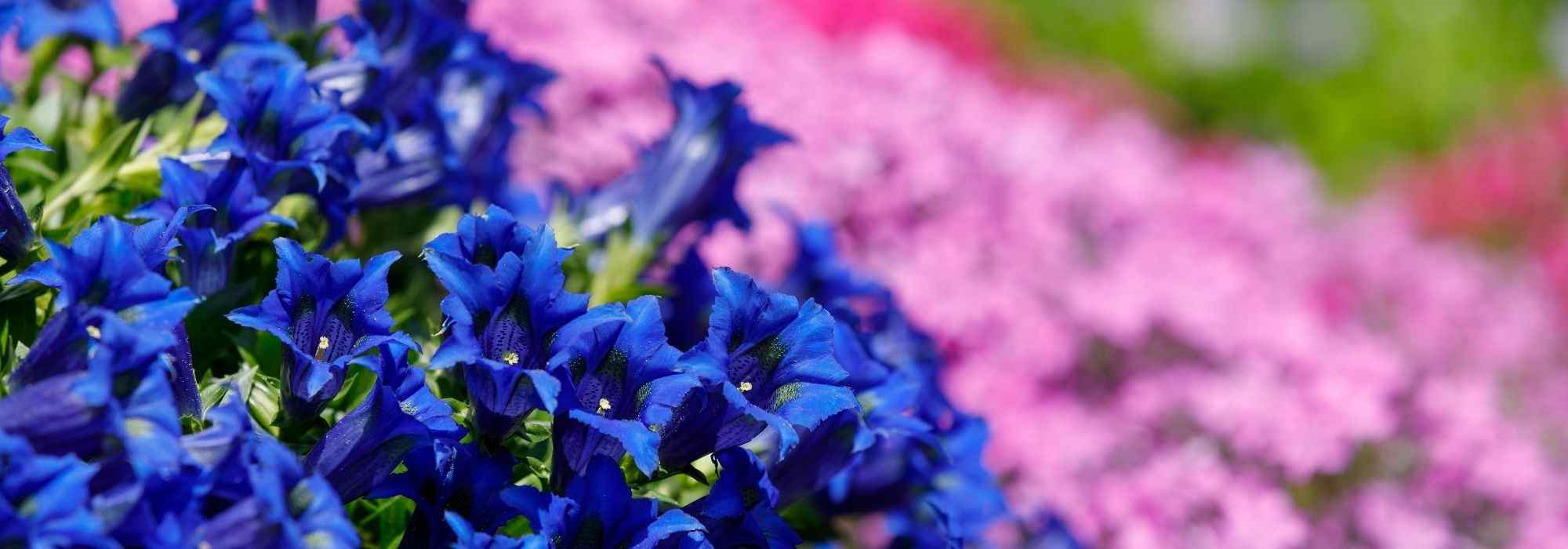
Pairing gentians in the garden
7 pairing ideas for this alpine perennial
Contents
With their trumpet or star-shaped flowers, gentians bring a wealth of beautiful colours to the garden. Yellow gentian or blue gentian, spreading or upright, small, medium, or large, there is a wide range of species and varieties that make a statement from spring to autumn. This very hardy alpine perennial thrives in non-burning sun as well as in partial shade, ideally in well-drained, cool soil. Gentians are suitable for many uses: in pots or containers, in rockeries, in borders, and in a naturalistic garden. To successfully pair gentians with other plants, discover our ideas for creating striking displays!
You can also find all our tips on planting, cultivating, and maintaining gentians in our comprehensive guide.
→ Are gentians suitable for your garden? Ensure you plant appropriately with our web application Plantfit.
In a spring pot in blue and yellow
For a spring display, choose a gentian that flowers in April or May, such as Gentiana acaulis or Gentiana verna. Their intensely blue flowers pair beautifully with yellow. This contrast of opposing colours brings cheer and brightness after the winter gloom! These two carpeting gentians can be accompanied by biennial plants such as Myosotis ‘Blue Sylva’ with its tiny blue flowers and the vibrant horned violets ‘Sorbet Xp Lemon Ice Blotch’ and ‘Sorbet Xp F1 Yellow’ in yellow. Plant a few small spring bulbs like the daffodil (‘New Baby’ or ‘Tête à tête’) and the Muscari azureum in sky blue or the variety Muscari armeniacum ‘Big Smile’. Finally, the foliage of a small bicolour grass like Carex oshimensis ‘Evercream’ creates a lovely effect as it gently spills over the container.
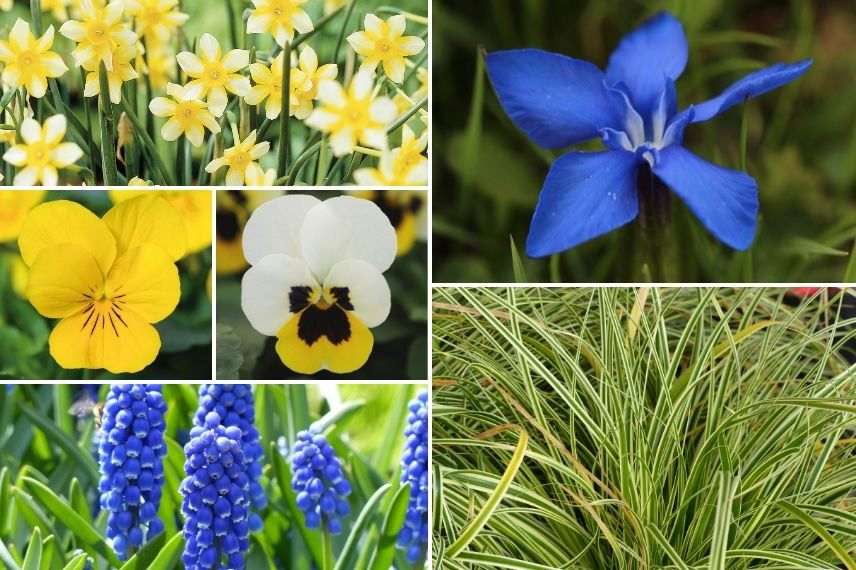
Daffodil ‘New Baby’, Viola cornuta ‘Sorbet Yellow’, Viola ‘Sorbet Lemon Ice Blotch’, Muscari ‘Big Smile’, Gentiana verna (photo Bjorn S) and Carex ‘Evercream’
Read also
Gentian: planting, growing and careIn summer pots
Many gentians bloom in summer. There’s nothing simpler than creating a summer planter by combining different species and varieties of gentians. For example, you can form a trio by pairing the white-flowered gentian Gentiana makinoi ‘White Magic’ with the pink-flowered hybrid gentian ‘Little Pinkie’ and the blue-flowered gentian Gentiana makinoi ‘Blue Star’. It is also possible to form a blue and white duo with the bright blue Gentiana septemfida var. lagodechiana and the bicoloured blue and white Gentiana scabra ‘Royal Stripes’. Both of these form cushions about thirty centimetres in all directions and bloom during the same period.
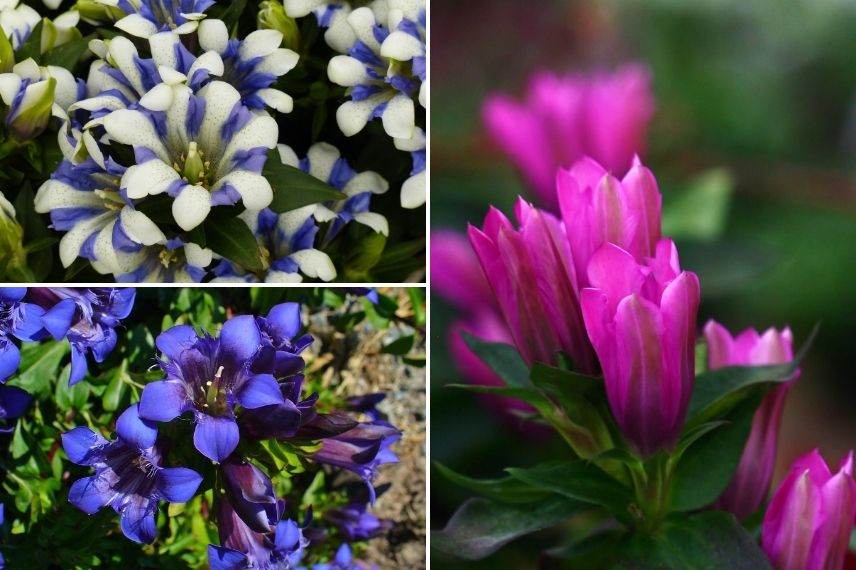
Gentiana ‘Royal Stripes’, Gentiana septemfida var. lagodechiana (photo Wikipedia) and Gentiana ‘Little Pinkie’ (photo Roy Lomas)
Discover other Gentian
View all →Available in 2 sizes
Available in 1 sizes
Available in 1 sizes
Available in 1 sizes
Available in 1 sizes
Available in 1 sizes
Available in 1 sizes
Available in 2 sizes
Available in 1 sizes
Available in 1 sizes
In autumn potting
With a flowering period from September to October, Gentiana sino-ornata, or autumn Chinese gentian, is perfect for adding colour to terraces and balconies in the late season. Its large trumpet-shaped blue flowers, striped with white, easily pair with white colchicums such as the double-flowered Colchicum autumnale ‘Alboplenum’, the single-flowered ‘Album’, or the vigorous and floriferous Colchicum speciosum ‘Album’. Pink or salmon chrysanthemums (for example, Chrysanthemum indicum ‘Orchid Helen’ and ‘Herbstbrokat’) can also accompany our gentian. Finally, the ‘Little Bunny’ Fountain Grass adds texture to the pot with its very fine foliage and soft spikelets.
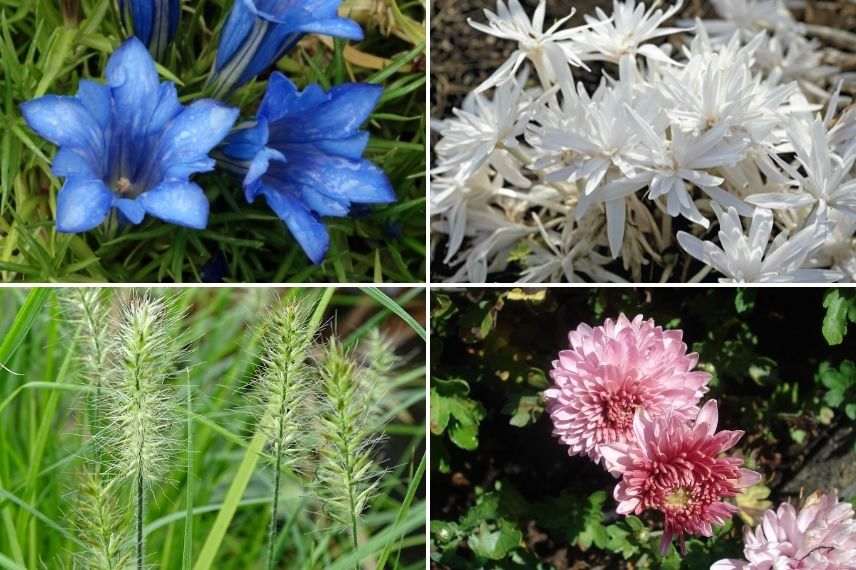
Gentiana sino-ornata, Colchicum autumnale ‘Alboplenum’ (copyright GWI Terry Jennings -MAP Mise au point), ‘Little Bunny’ Fountain Grass and Chrysanthemum indicum ‘Orchid Helen’
In a cool rockery
Alpine plant par excellence, gentian is ideal for rockeries. Flowering in different seasons, it can be present for a good part of the year if one chooses species with successive flowerings. In spring, Gentiana acaulis with its creeping habit, also known as alpine gentian, pairs wonderfully with the Edelweiss, which is also native to the mountains. The subulate sagina and saxifrages are also good companions, carpeting the rockeries with small white or pink flowers. In summer, Gentiana septemfida var. lagodechiana can be associated with houseleeks which thrive in stony soils. The rosettes of these succulent plants offer a wide range of colours depending on the species and varieties. They withstand the cold very well, surviving through winter. Preferring cool soils, the montane Androsace sarmentosa displays a summer flowering of small pink to mauve flowers, inserted in bouquets on short stems. Finally, the autumn gentian allows us to enjoy its flowers until October alongside dwarf autumn asters (Aster dumosus ‘Rosenwichtel, ‘Schneekissen’ or ‘Lady in Blue’) and autumn Sedum such as Sedum spectabile ‘Meteor’ or ‘Yellow Xenox’.

Leontopodium alpinum, Gentiana acaulis (photo maya dumat), Sagina subulata and Saxifraga arendsii ‘Pixie’
In a flower bed
Of medium size, the asclepiad gentian fits perfectly in the heart of a border in partial shade. To accompany it, choose perennials that are interesting for their foliage, such as hostas offering green, golden, blue, or variegated leaves. For example, the Hosta fortunei ‘Patriot’ displays large rounded leaves margined in white and lavender blue flower spikes in summer. The very graphic fronds of ferns are also part of the mix. For instance, the Japanese fern ‘Pewter Lace’ adds a refined and luminous touch to the border with its silver-green foliage. This harmonises with the Chinese lysimachia with its white flower spikes, as well as with the Astilbe thunbergii ‘Professor van der Wielen’ which grows to about 1 m in height and can be placed in the background. Like Gentiana asclepiadea, these two perennials flower during the summer, between July and September. For a long flowering period, plant the corydalis ‘Porcelain Blue’, a repeat flowering variety that then colours the garden with its sky blue and turquoise tubular flowers in spring, and again in late summer to early autumn.
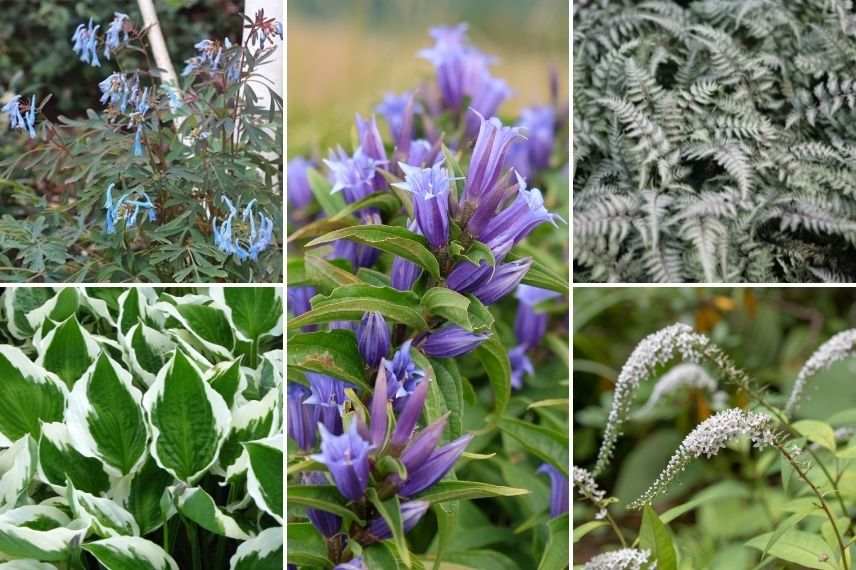
Corydalis ‘Porcelain Blue’, Gentiana asclepiadea, Athyrium ‘Pewter Lace’, Hosta ‘Patriot’ and Lysimachia clethroides
In a naturalistic garden
The Gentiana lutea easily fits into naturalistic gardens thanks to its tall silhouette that can sometimes reach over 1.20 m in height and its very natural style. It can be placed alongside knotweeds such as Persicaria amplexicaulis ‘Rosea’ with its wild appearance. In this wild setting, upright grasses are essential. The molinie, for example, adds lightness by spreading its tuft of fine, airy inflorescences. Standing tall, the majestic calamagrostis, golden in winter, instils a rustic spirit. Add perennials to this sunny natural area, such as Phlomis of Russell, the wild teasel, the Virginia veronica, the giant scabious, or even yarrow. Do note that the Great yellow gentian grows slowly and its first summer flowering only occurs after a few years. So, patience!
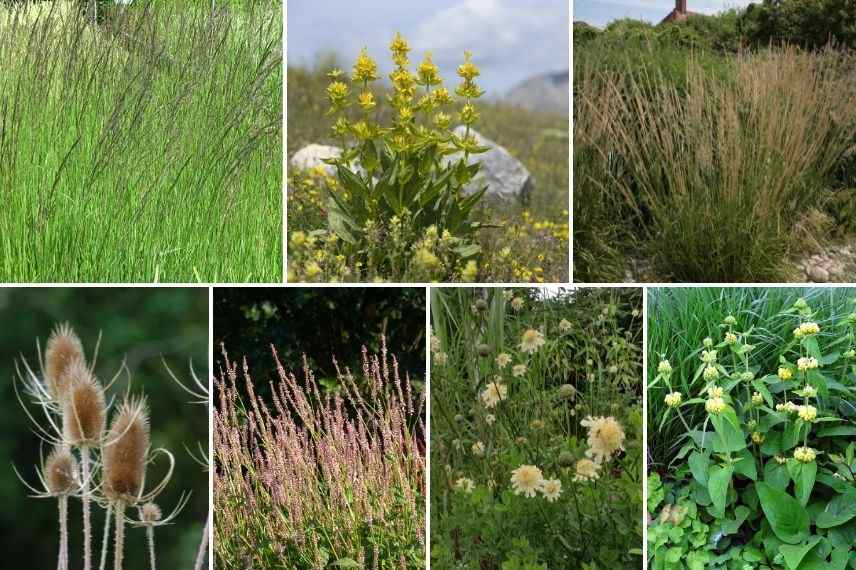
Molinia ‘Fontäne’, Gentiana lutea, Calamagrostis ‘Walderbuch’, Dipsacus fullonum (photo Ellywa), Persicaria ‘Rosea’, Cephalaria gigantea and Phlomis russeliana
In a border
The lowest varieties of gentians (Gentiana acaulis, Gentiana verna…) look great in borders. Blue gentians easily complement grey foliage. Spreading a dense carpet of soft-to-the-touch leaves, Stachys bizantina is ideal for borders. For delicate flowering, opt for theErigeron karvinskianus or theErigeron eiomerus, which are versatile perennials, comfortable both at the top of a wall and at the edge of a path or border. Very floriferous from spring to summer, they produce a cloud of small daisy-like flowers. Dwarf irises, such as theIris germanica ‘Petit Moment’ and theIris germanica ‘Katy Petts’, peeking out from April to May, are also suitable. Well-structured, they add rhythm to the border. Finally, let’s not forget the small campanulas that cover empty spaces with a lovely tufted cushion of bell-shaped flowers (wall campanula, Campanula poscharskyana ‘Stella’, Campanula garganica).
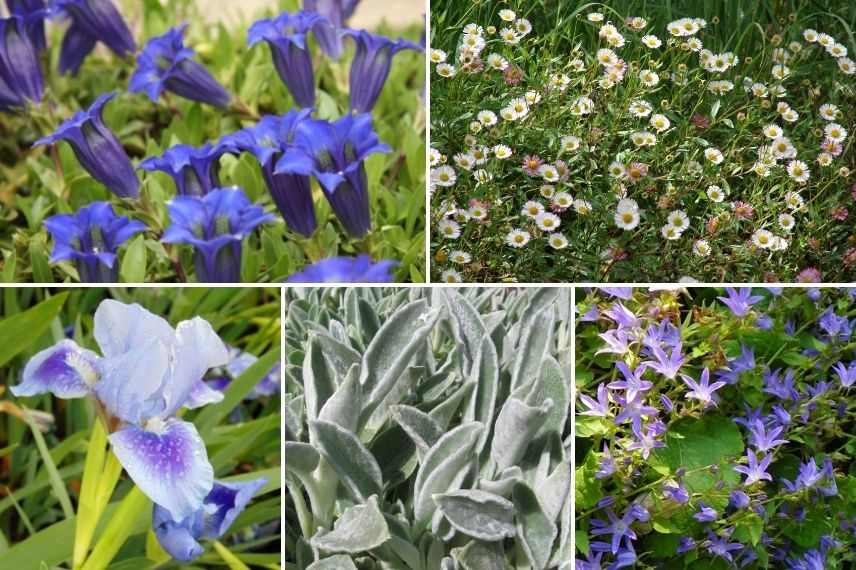
Gentiana acaulis (photo maya dumat), Erigeron karvinskianus, Iris ‘Katy Petts’, Stachys bizantina (photo A_Poulos) and Campanula poscharskyana ‘Stella’
For further reading
- Subscribe!
- Contents
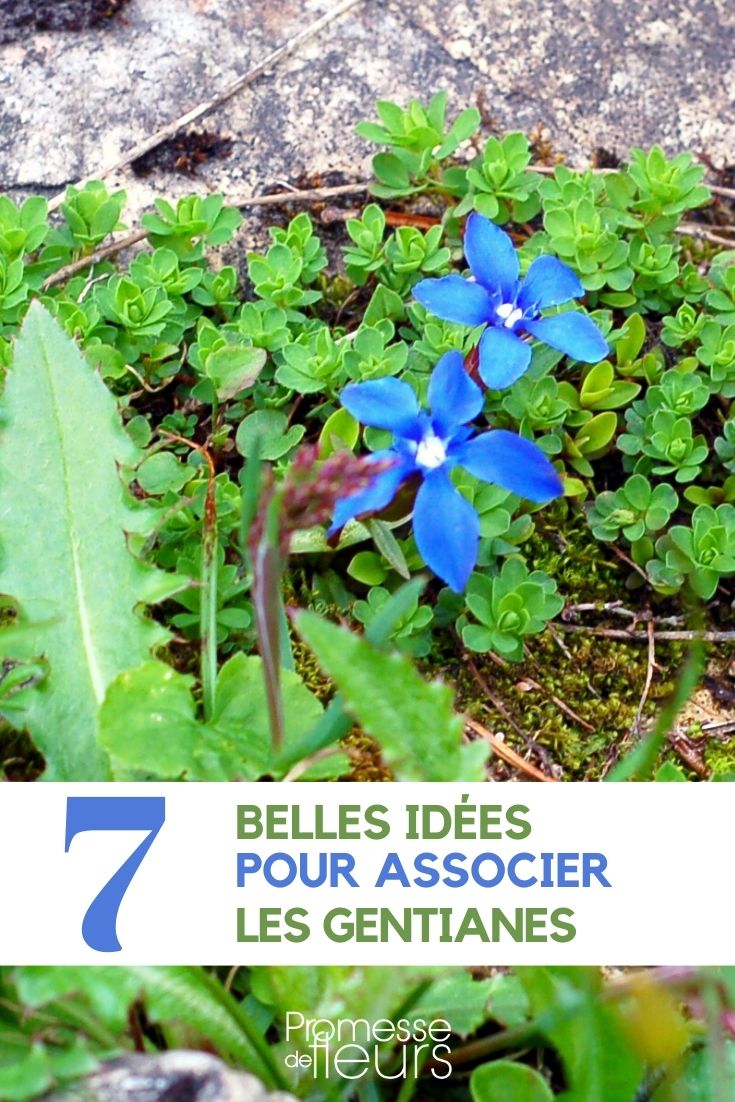































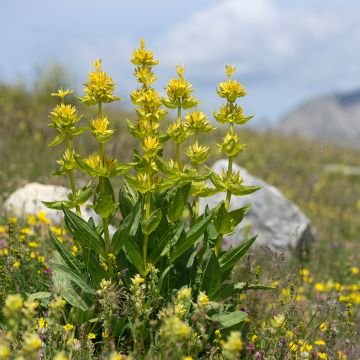

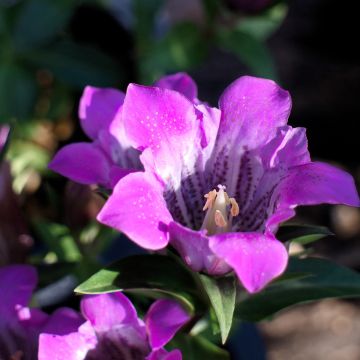



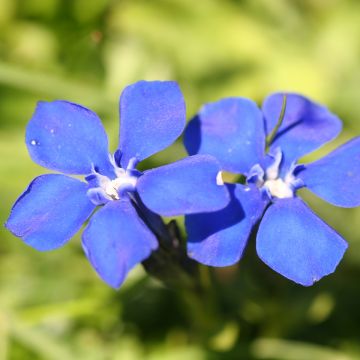

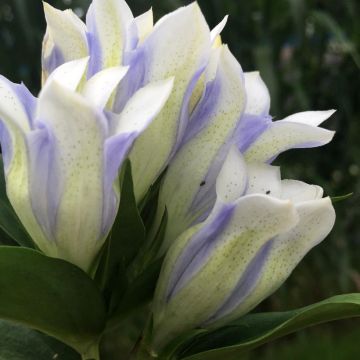
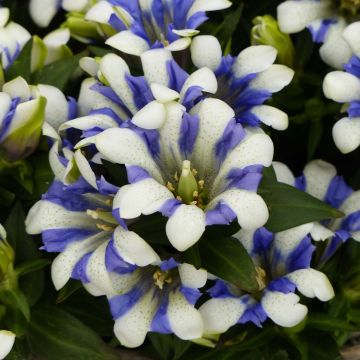
Comments